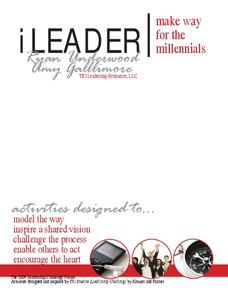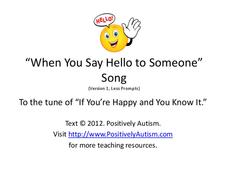Curated OER
Silly to Serious Cards and Panels
What are the unwritten rules of formality in different social situations? Help learners identify when it is the appropriate time to be silly, funny, or serious with this collection of illustrated panels and cards.
Curated OER
Self-Control Meters for Volume, Space and Levels of Formality
If your pupils have difficulty producing the appropriate voice volume in various settings or respecting personal space, refer to this "control-o-meter" device. This resource includes materials to create three meters for you to...
Orange County Department of Education
Poppa's New Pants
Angela Shelf Medearis' Poppa's New Pants provides third graders with an opportunity to stitch together their own narrative filled with sensory details. After reading the story and noting the sensory and concrete details in the tale...
California Department of Education
Etiquette? What’s That?
Business etiquette is a big deal! Are your scholars prepared to impress in the business world? The third in a series of six college and career readiness lessons focuses on basic behaviors in business situations. Groups research specific...
Leadership Challenge
Rock the Clock
Watch young leaders as they totally rock this activity! Pupils partner up and set appointments with one another during the third in a series of 12 character-building lessons. Instructors call out the appointment time, then partners meet...
Goodwill Community Foundation, Inc.
Manners and Etiquette
Learning how to speak Spanish is incomplete if you're not speaking politely! Teach class members the basics of Spanish manners, including perdón, lo siento, and salud to reinforce their conversational etiquette.
Universal Press Syndicate
The Mini Page: Make It a Good New Year
The New Year is a time for reflecting on the previous year in order to make resolutions and set goals for self improvement. With multiple suggestions towards becoming a better classmate, student, friend, and healthy person, the...
Social Skills Central
Photo Cartoons: Being Polite
Have you ever been left out of plans your friends were discussing? This photo cartoon will help your learners recognize that being polite can go beyond just saying please and thank you by making sure others feel included and...
Positively Autism
"When Mom is on the Phone" Social Skills Story
How should youngsters act when their parents are on the phone? Using the story slides in this resource, your learners will discover the importance of not interrupting a parent's phone call and how to whisper or play with toys quietly.
Positively Autism
"Share the Road" Folder/Shoebox Games
Introduce the importance of sharing and taking turns with your learners through a hands-on learning experience involving toy cars! Here you'll find activity instructions and printables to support your "Share the Road" collaborative...
Positively Autism
"Saying "Hello" to People" Social Skills Story
Support learners who may be very shy or reserved in saying "hello" to new people with this set of story slides. The presentation begins with a few slides describing why it is good to greet others, and concludes with opportunities to...
Positively Autism
"Other People Can Be First" Social Skills Story
Remind learners that sometimes other people might like to be first to answer questions, drink from the water fountain, get to the classroom, and other common daily events. This resource includes nine story slides of visuals and simple...
Positively Autism
"Saying 'No, Thank You'" Social Skills Story
Teach learners to use polite words when they do not want something, rather than being rude or aggressive, using these simple presentation slides. The presentation walks students step by step through what it means to say "No,...
Positively Autism
Song: Eye Contact When Greeting
When you say hello to someone, look at their eyes! Set to the tune of "When You're Happy and You Know It," this activity helps learners on the autism spectrum build a valuable social and conversational skill.
Do2Learn
Social: Behavior
What does "good behavior" look like? Set clear guidelines for what type of behavior is expected in different situations, and ensure your learners understand the verbal cues that you provide.
August House
Anansi And Turtle Go To Dinner
That tricky Anansi! Join him and Turtle in the story Anansi and Turtle Go to Dinner by Bobby and Sherry Norfolk, based on the African folktale. Kids answer comprehension questions and sing songs about spiders before creating spider...
Colonial Williamsburg Foundation
Colonial Williamsburg: Experience Colonial Life
Experience colonial life through a variety of narratives. Topics include the African-American experience, animals, Christmas, clothing, family, food, gardening, manners, politics, religion, tools, and trades.
Sophia Learning
Sophia: Characterization Through Description
This slideshow focuses on authors defining characters through description such as features, dress, mannerisms, emotions, and objects. It provides several examples from Bram Stoker's "Dracula."
Unite for Literacy
Unite for Literacy: Friends: Say Something Nice
Young children demonstrate how to talk nicely and use their manners. Includes audio narration in English, Spanish, and Turkish with text in English.
Unite for Literacy
Unite for Literacy: Cboces: Migrant Education Program: What Good Is a Line?
Learn about all the different ways that people use lines. Includes audio narration in 15 additional languages with text in English.
Other
How to Set a Table
Step by Step guide from SM Publications on how to set an informal or a formal table. Includes diagrams and tips.
Digital History
Digital History: History of Private Life an Overview
Digital History provides a look at various cultures and traditions of mankind through the ages. Discusses the purpose and values of the private life.
Other
Business Etiquette: More Than Just Eating With the Right Fork
So many people forget about common courtesies as a form of communication. These tips are vital for business success.
Alabama Learning Exchange
Alex: "Tables Gone Wild"
What's going on with this "Wild Table?" This instructional activity is designed to help the learner work collabaratively, creatively as well as separately to properly set the dinner table. This instructional activity will also infuse...























